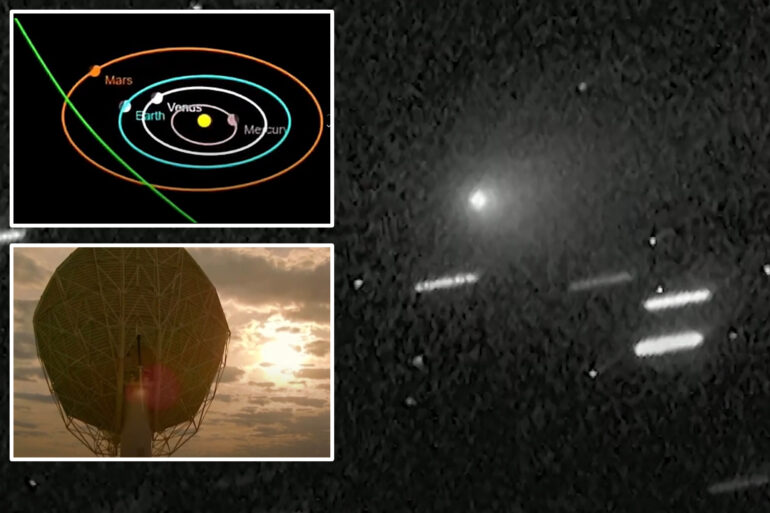🔴 Website 👉 https://u-s-news.com/
Telegram 👉 https://t.me/usnewscom_channel
Was Oumuamua a space probe?
Is 3I/ATLAS another?
If so, why haven’t they said hello?
The humble residents of this pale blue dot have been on a quest to find an alien civilisation for more than a century.
First, it was the “canals” of Mars.
Then there were enigmatic radio “lighthouses.”
And the famous “Wow” signal.
All have ended up with mundane and mechanical explanations.
“It stands to reason that the Universe should be buzzing with activity, but we’ve been searching for signals for decades and haven’t heard zip,” bemoans the Planetary Society’s Kate Howells.
One after another, theories about where and how technologically advanced interstellar civilizations can be found have fallen by the wayside.
But, as technology advances, the scope for this search broadens.
New telescopes, probes and techniques are in the pipeline.
And new ideas of what to look for.
As one Breakthrough Listen project astronomer believes, the evidence may already be right there before us.
We just haven’t recognized it yet.
Brian Lacki has released a set of three prepublication studies attempting to rationalize and measure the odds of a galactic-scale civilization.
These, he argues, are already be in view.
They are “radio-bright” galaxies – those broadcasting especially loud background noise.
“The trouble is that you can’t tell whether that emission is natural or artificial just from knowing how bright it is in the radio band,” Lacki told Universe Today.
“We expect it is natural in almost all, if not all, cases.”
The challenge, he adds, is separating a signal from the noise.
It’s a problem other astronomers are tackling on a much narrower scale.
They think they’ve found traces of water and carbon dioxide in the atmospheres of distant worlds.
But telltale signs such as methane and oxygen are hard to discern.
But the University of California thinks we’ve simply been looking for the wrong things.
Methyl halides are much easier to define.
And they’re made by microbes critical in supporting more advanced life.
“If we start finding methyl halides on multiple planets, it would suggest that microbial life is common across the universe,” argues planetary scientist and study author Michaela Leung.
Signals amid the noise
A radio search of the heavens began in the 1960s with the Search for Extraterrestrial Intelligence (SETI).
Despite the odd false alarm, ET is yet to phone home.
Lacki, however, thinks the dial tone is out there.
And it may be so bright, and so common, we think it’s just a natural part of the universe.
The Breakthrough Listen project was initiated in January 2016.
It took a bucket of money from global corporate and government donors to conduct the most comprehensive radio survey of space yet.
Their findings are now being released.
Lacki’s study, “Artificial Broadcasts as Galactic Populations,” has been posted to the preprint science journal arXiv.
In it, he argues radio-bright galaxies may be bursting at the seams with advanced civilizations.
The idea is that a single distant civilization would be indiscernible from the natural radio background.
But a galaxy-spanning civilization would be mistaken as part of the natural background itself.
“If there were some ancient alien civilization that had been broadcasting for thousands, millions, or even billions of years, those signals would have been able to travel pretty far,” the Planetary Society’s Howells argues.
“But signal strength tends to diminish with distance, so if those alien broadcasters were far enough away, we still might not be able to detect their communications.”
Confounding the issue is that the supermassive black holes at the centre of most galaxies (such as our own, Sagittarius A) are radioactive.
And this activity varies with how many stars it’s recently devoured.
But Lacki argues the overlapping radio transmissions of millions of worlds would, at intergalactic distances, look as though they were part of this.
He believes one in every 100 large galaxies could be populated enough to contribute about 1/300th of a galaxy’s radio luminosity.
Likewise, extracting the spectral signature of life from light passing through the atmospheres of (relatively) nearby worlds is also challenging.
But a study published in the Astrophysical Journal Letters suggests existing telescopes have been looking for the wrong things.
“With our current technology, oxygen is extremely difficult to detect on Earth-like planets, so it’s only logical to look for something more visible, like methyl halides,” the researchers argue.
Their presence is a sign of microbial life, such as fungi, algae and bacteria. And they can be identified with as little as 13 hours of James Webb Deep Space Telescope time, unlike the days needed for the current favourites.
And the life they support doesn’t have to depend on oxygen.
“They’d be adapted to a very different type of environment, and we can’t really conceive of what that looks like, except to say that these gases are a plausible output from their metabolism,” argues astrobiologist Eddie Schwieterman.
Against the odds
Are we normal?
Or abnormal?
Should we be basing our expectations of life out there on what we know here?
University of Columbia astronomer Professor David Kipping argues humanity is a statistical outlier.
“Yes, the sun is one of billions of stars, but several properties clearly make it unusual among that sample,” he said.
Our Sun is a yellow G-dwarf star.
These account for only a few percent of the galaxy’s known population.
“Even among those, the sun is somewhat odd in being a fairly quiescent, single star system accompanied by two Jupiter-sized planets,” Professor Kipping adds.
Jupiter’s position in our solar system allows it to act as a giant sponge, soaking up deadly asteroids and comets before they reach the inner planets.
But most observed systems tend to hug these giants much closer to their stars than their rocky planets.
The most common stars in the galaxy are M-dwarfs (Red Dwarfs).
These are home to most of the 6000 or so extrasolar planets currently identified.
“Yet we do not live around one, something which I called the Red Sky Paradox,” Professor Kipping observes.
The volatile nature of these Red Dwarfs may mean life doesn’t get a chance to advance to an advanced technological stage.
Because these stars are cooler, planets must be closer to sit in the “Goldilocks” zone needed to support liquid water.
This puts them in reach of sunspots and flares.
And then there’s the matter of time.
“Our own planet’s signals have probably only reached about 100 light-years into space,” writes the Planetary Society’s Howells.
“We’ve only been broadcasting electromagnetic communications for about that long, and nothing can travel faster than lightspeed, hence the limited distance.”
Professor Kippling puts this into perspective.
“The stelliferous (active star) period of the universe extends until 10,000 Gyr (giga-years) from now,” he writes.
“Yet here we are living in the first 0.1 percent of that window, when the universe is just 13.8 Gyr old”.
Where there’s hope, there’s life
“There’s the hopeful idea that we’re just the first ones to get to this point of development,” Howells explains.
“There’s the fun, far-out idea that advanced aliens prefer to expand in virtual reality rather than colonize other planets. And there are lots more ideas in between.”
Perhaps we’re not listening – or looking – for the right thing.
Perhaps we’re far too impressed with our own technology, assuming others haven’t long since moved on to much more advanced means.
“Maybe alien tech uses communication methods we don’t understand or can’t harness yet, like quantum entanglement,” Howells adds.
We’ve got a long way to go yet.
And that may be the underlying problem.
Dr. Manuel Scherf and Professor Helmut Lammer of the Austrian Space Research Institute think the influence of plate tectonics on atmospheric carbon dioxide is another time limit for a planetary civilization to go interstellar.
“At some point, enough carbon dioxide will be drawn from the atmosphere so that photosynthesis will stop working,” says Scherf.
“For Earth, that’s expected to happen in about 200 million to roughly 1 billion years.”
Worlds also need atmospheres with at least 18 percent oxygen.
Anything less won’t support larger, complex animals.
Change block type or style
Or allow the crucial invention of fire.
Anything over 21 percent makes fire uncontrollable.
“Without fire, the smelting of metal would be unfeasible and a technological civilisation would be impossible,” they explain.
Taking these factors into account, Scherf and Lammer argue that a planet with 10 per cent carbon dioxide would sustain photosynthesis for 4.2 billion years.
And any civilization that develops there must survive a minimum of 280,000 years for a chance of overlapping the appearance of another civilization in the same galaxy.
“For 10 civilisations to exist at the same time as ours, the average lifetime must be above 10 million years,” says Scherf.
“The numbers of ETIs (extraterrestrial intelligences) are pretty low and depend strongly upon the lifetime of a civilization.”
As yet, there is an absence of evidence of any such civilization existing.
But no evidence of absence.
“The only definitive answer we can ever get to the question of whether other life exists out there is ‘yes,” Howells concludes.
“Until we get that confirmation of alien life, the possibility will always remain that we just haven’t found it yet.”

